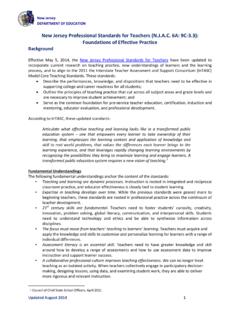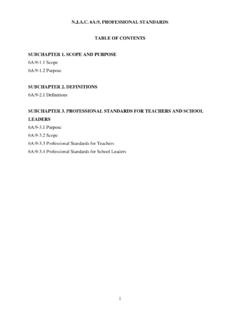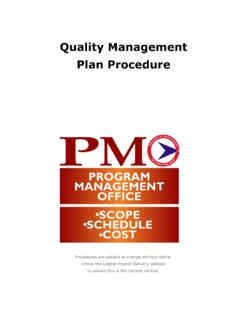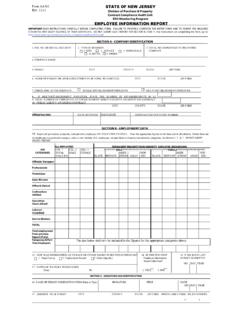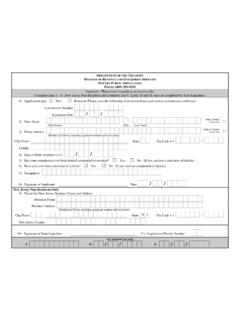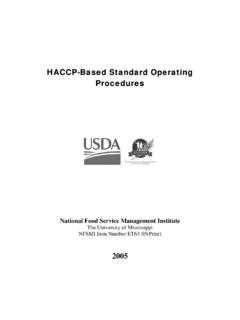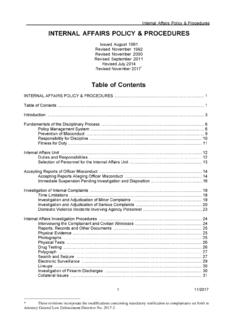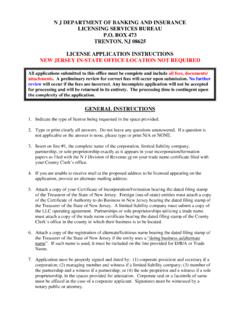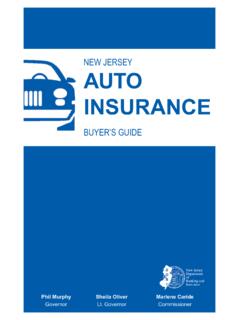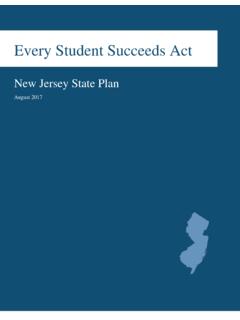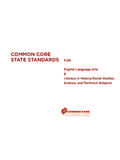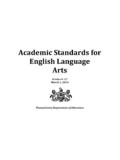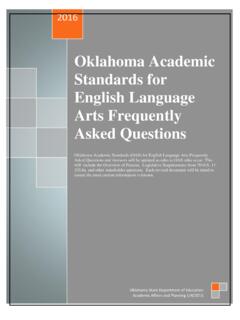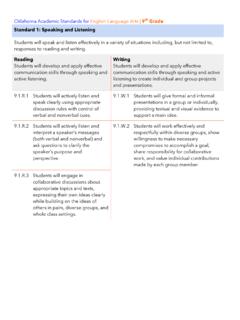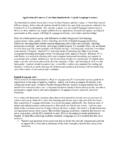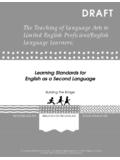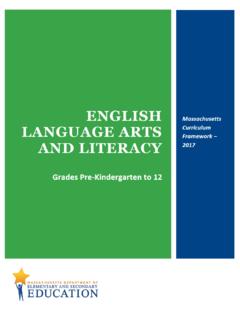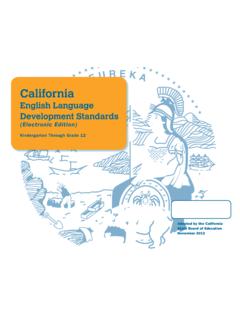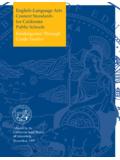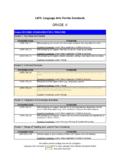Transcription of New Jersey Student Learning Standards for English Language ...
1 New Jersey Student Learning Standards for English Language Arts Grade 1 The New Jersey Student Learning Standards define general, cross-disciplinary literacy expectations that must be met for students to be prepared to enter college and workforce training programs ready to succeed. The K 12 grade-specific Standards define end-of-year expectations and a cumulative progression designed to enable students to meet college and career readiness expectations no later than the end of high school. Students advancing through the grades are expected to meet each year s grade-specific Standards , retain or further develop skills and understandings mastered in preceding grades, and work steadily toward meeting the more general expectations described by the Standards .
2 Anchor Standards : Reading Key Ideas and Details Read closely to determine what the text says explicitly and to make logical inferences and relevant connections from it; cite specific textual evidence when writing or speaking to support conclusions drawn from the text. Determine central ideas or themes of a text and analyze their development; summarize the key supporting details and ideas. Analyze how and why individuals, events, and ideas develop and interact over the course of a text. Craft and Structure Interpret words and phrases as they are used in a text, including determining technical, connotative, and figurative meanings, and analyze how specific word choices shape meaning or tone.
3 Analyze the structure of texts, including how specific sentences, paragraphs, and larger portions of the text ( , a section, chapter, scene, or stanza) relate to each other and the whole. Assess how point of view or purpose shapes the content and style of a text. Integration of Knowledge and Ideas Integrate and evaluate content presented in diverse media and formats, including visually and quantitatively, as well as in words. Delineate and evaluate the argument and specific claims in a text, including the validity of the reasoning as well as the relevance and sufficiency of the evidence. Analyze and reflect on how two or more texts address similar themes or topics in order to build knowledge or to compare the approaches the authors take.
4 New Jersey Student Learning Standards for English Language Arts Range of Reading and Level of Text Complexity Read and comprehend complex literary and informational texts independently and proficiently with scaffolding as needed. Note on range and content of Student reading To build a foundation for college and career readiness, students must read widely and deeply from among a broad range of high-quality, increasingly challenging literary and informational texts. Through extensive reading of stories, dramas, poems, and myths from diverse cultures and different time periods, students gain literary and cultural knowledge as well as familiarity with various text structures and elements.
5 By reading texts in history/social studies, science, and other disciplines, students build a foundation of knowledge in these fields that will also give them the background to be better readers in all content areas. Students can only gain this foundation when the curriculum is intentionally and coherently structured to develop rich content knowledge within and across grades. Students also acquire the habits of reading independently and closely, which are essential. Grade 1 Progress Indicators for Reading Literature Text Key Ideas and Details Ask and answer questions about key details in a text. Retell stories, including key details, and demonstrate understanding of their central message or lesson.
6 Describe characters, settings, and major event(s) in a story, using key details. Craft and Structure Identify words and phrases in stories or poems that suggest feelings or appeal to the senses. Explain major differences between books that tell stories and books that give information, drawing on a wide reading of a range of text types. Identify who is telling the story at various points in a text. Integration of Knowledge and Ideas Use illustrations and details in a story to describe its characters, setting, or events. (Not applicable to literature) Compare and contrast the adventures and experiences of characters in stories. New Jersey Student Learning Standards for English Language Arts Range of Reading and Level of Text Complexity With prompting and support, read and comprehend stories and poetry at grade level text complexity or above.
7 Grade 1 Progress Indicators for Reading Informational Text Key Ideas and Details Ask and answer questions about key details in a text. Identify the main topic and retell key details of a text. Describe the connection between two individuals, events, ideas, or pieces of information in a text. Craft and Structure Ask and answer questions to help determine or clarify the meaning of words and phrases in a text. Know and use various text features ( , headings, tables of contents, glossaries, electronic menus, icons) to locate key facts or information in a text. Distinguish between information provided by pictures or other illustrations and information provided by the words in a text.
8 Integration of Knowledge and Ideas Use the illustrations and details in a text to describe its key ideas. Identify the reasons an author gives to support points in a text and explain the application of this information with prompting as needed. Identify basic similarities in and differences between two texts on the same topic ( , in illustrations, descriptions, or procedures). Range of Reading and Level of Text Complexity With prompting and support, read informational texts at grade level text complexity or above. New Jersey Student Learning Standards for English Language Arts Grade 1 Progress Indicators for Reading Foundation Skills Print Concepts Demonstrate mastery of the organization and basic features of print including those listed under Kindergarten foundation skills.
9 A. Recognize the distinguishing features of a sentence ( , first word, capitalization, ending punctuation). Phonological Awareness Demonstrate mastery of spoken words, syllables, and sounds (phonemes) by using knowledge that every syllable must have a vowel sound to determine the number of syllables in a printed word. A. Distinguish long from short vowel sounds in spoken single-syllable words. B. Orally produce single-syllable words by blending sounds (phonemes), including consonant blends. C. Isolate and pronounce initial, medial vowel, and final sounds (phonemes) in spoken single-syllable words. D. Segment spoken single-syllable words into their complete sequence of individual sounds (phonemes).
10 Phonics and Word Recognition Know and apply grade-level phonics and word analysis skills in decoding words. A. Know the spelling-sound correspondences for common consonant digraphs (two letters that represent one sound). B. Decode regularly spelled one-syllable words. C. Know final -e and common vowel team conventions for representing long vowel sounds. D. Distinguish long and short vowels when reading regularly spelled one-syllable words. E. Decode two-syllable words following basic patterns by breaking the words into syllables using knowledge that every syllable must have a vowel sound. Fluency Read with sufficient accuracy and fluency to support comprehension.
